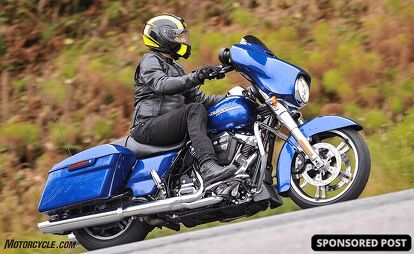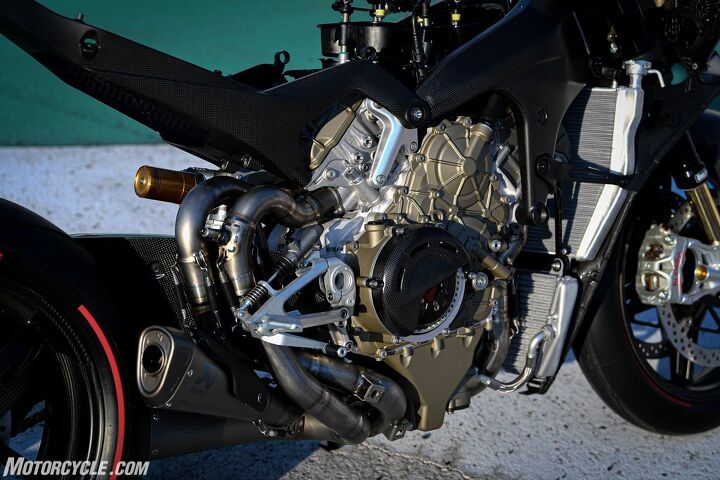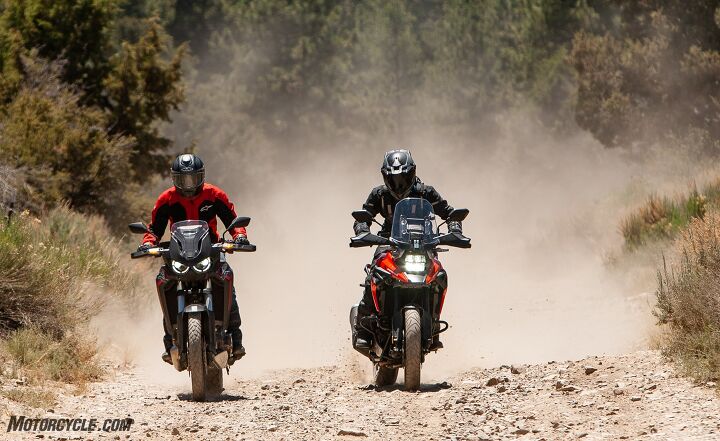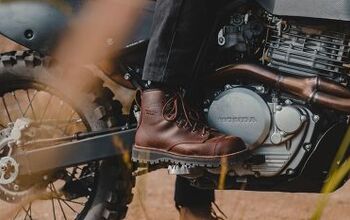How to Test Ride Practically Any Motorcycle
Renting from a pool of privately-owned motorcycles gives riders a virtually unlimited supply of bikes to choose from
Unlike cars, it’s not as easy to walk in to your local motorcycle dealership and take a bike for a test ride. And what do you do if you’re looking at buying a used model you can’t easily find in dealerships? Well, wonder no more. Thanks to the internet and the share economy it has helped create, companies like Riders Share let you easily rent a wide variety of popular motorcycles with a few taps of your phone screen, allowing you to test drive til your heart’s content. Go ahead – give it a try! But once you’ve got the bike in your hands, what sort of things should you be paying attention to?
This is a perfect question for the Motorcycle.com gang to answer – after all, testing motorcycles is our job. Here, we’ll take you through a few of the things going through our minds when we test bikes. Odds are, these are the same attributes you notice when riding, but if you’ve only ever ridden your motorcycle, your well of experience probably isn’t very deep. Since we’re fortunate enough to have ridden dozens upon dozens (hundreds, even?) of new models, we have the benefit of context and experience to draw from. We’ll tell you what we’re paying attention to so you can be more aware next time you ride an unfamiliar motorcycle.
So come along. Let’s go for a virtual ride on your next motorcycle rental.
Engine/Transmission
First and foremost, there’s the engine. Apart from a motorcycle’s aesthetics, an engine often dictates how the rest of our opinions will flow. Skipping aesthetics for now (you wouldn’t be riding the bike if you didn’t like the way it looked), the obvious thing to pay attention to with the engine is its power. How much power and torque does it make? Where does it make it?
We’re generalizing here, but regardless of the engine size itself, a high horsepower bike doesn’t always make for a winner; even on a sportbike, a narrow powerband or a “peaky” engine (where power is made near redline) is hard to ride and requires maximum concentration and attention. An easy-to-ride motorcycle has a broad spread of power, accessible early in the rev range, with a throttle connection that’s smooth and linear – meaning when you twist the throttle, power is delivered without hiccups, delays, or stutters.
Similarly, a good transmission is one you barely notice. We’ve grown fond of quickshifters and autoblippers that let you shift in either direction without the clutch, but there are plenty of new bikes without that technology – and, of course, older bikes don’t have it either. Whether you’re a clutchless upshifter or you use the clutch religiously on all shifts, a happy transmission is one that lets you click into gear seamlessly.
Depending on the age of the bike and the amount of maintenance it’s received, pay attention to the clutch pull. A higher number of clutch springs (and/or stiff springs) will make the pull a little harder, but then again, this can also be the result of a clutch cable in desperate need of lube. Lubrication doesn’t apply to bikes with hydraulic clutches, but you still need to pay attention to irregularities – it’s possible the clutch may need new fluid and a bleed.
Ride Quality
Since motorcycles need to be ridden to be tested, you’re concurrently keeping mental tabs of the ride quality while you’re also getting used to the engine. First things first, make sure the controls are in a comfortable position. Some bikes have adjustable levers, others don’t. Either way, taking note of where your hands and feet are placed is a good first step. If you’d prefer them somewhere else, odds are the aftermarket has a solution.
Depending on the bike’s intended purpose (cruiser, tourer, sportbike, dirtbike, etc.) you expect certain things. On touring bikes or cruisers, you’re looking for a plush, comfortable ride. You should expect the suspension to lean towards the soft side, absorbing bumps so you don’t have to. As you move up the sportiness scale, you should expect to give up more and more plushness in exchange for a firmer, more accurate ride. The same holds true for off-road bikes, to a degree.
Beyond how soft or firm the suspension is, also pay attention to how slow or how quickly the bike leans into turns, how it behaves once you’re in the turn, and what it does when you’re coming out. Different wheel sizes have an effect here, as do rake, trail, and wheelbase numbers, but delving deeper into those things is beyond the scope of this article.
For many, suspension and handling is a black art or mysterious creature, but it doesn’t have to be. Most handling woes are curable. You just need to pay attention to what’s happening and be able to explain it.
Take notes. Write down what the current settings are, then note whatever changes you make. If the bike feels better, keep making changes (and noting them) until it doesn’t. If the changes are worse, at least you have the previous settings written so you can go back to them.
Brakes
This one seems fairly obvious, doesn’t it? How well does it stop? There’s slightly more nuance to it than that, though. First of all, is the brake lever adjustable? If not, how awkward is it to reach for the lever? Once that’s out of the way, you can pay attention to the “bite” you get when you first apply the brakes. Different pad materials offer a strong initial bite while others ramp up stopping power progressively. Neither is better or worse; it comes down to personal preference.
If you’re riding an ABS-equipped motorcycle, get comfortable finding the activation point for the ABS. Again, all models are calibrated differently, so you might activate it on one bike earlier than you might expect. But getting comfortable with the feel of a pulsing lever in a non-emergency environment is a good idea in case you have to use it in an “Oh Sh*t” moment. This same concept applies for bikes with Cornering-ABS, though we understand if you’d rather not find these limits.
Lastly, some motorcycles allow you to adjust the sensitivity of the ABS, or even turn it off entirely. Scroll through the menus on your rental bike to familiarize yourself in how to do this. It might come in handy one day.
Electronics
Speaking of pushing buttons, modern motorcycles are full of different buttons to press and menus to navigate. Love it or hate it, electronic rider aids are here to stay. So you might as well get used to them. Use the owner’s manual if you have it. Otherwise, ask the owner or the dealer to help you navigate the menus. Learn the sequence of button presses, or at least the ones that pertain to your needs.
For example, we play with the traction control and ride mode settings on nearly all the bikes we ride. Generally, the difference between the ride modes is obvious and you can pick the one you like the best. As far as traction control settings go, dialing in more intervention to start with is the safe option, then you can dial it back from there.
Bikes with electronic suspension can seem daunting at first, but don’t feel intimidated. Instead of busting knuckles with tools turning clickers and knobs, changing the dynamics of your ride is a button press away. Motorcycles with electronic suspension generally have dedicated menu screens to toggle through and adjust. If they don’t, they’ll at least have specific symbols displayed on the dash. Familiarize yourself with the buttons and screens, then set everything to the middle of the range to start. After some miles, reassess those settings and make the necessary changes.
How Well Does It Perform Its Intended Function?
Now comes the time when you actually see what the motorcycle can do! Go ride and just soak up what the rented motorcycle gives you. Of course, you need to keep your expectations in check. If you’re trying a cruiser, don’t expect it to act like a sportbike (and vice versa). If you’re riding an adventure bike, realize there might be some concessions compared to a dedicated touring bike that make it great off-road.
In general, pay attention to these things:
- Comfort (seating position, bar placement, ergonomics, vibrations, wind protection, etc.)
- Performance (power, power delivery, fuel economy)
- Handling
- Electronics (after you’ve adjusted the settings, do the electronics enhance the ride, detract from it, or can you even notice it at all?)
This is probably the part needing the least amount of explanation, since this is the whole reason we take motorcycles on test rides, anyway. But in case you need some specifics to pay attention to, these are things to consider.
X-Factors
The less obvious characteristics of a motorcycle, and the ones you won’t find listed in any spec sheet, are what we call the x-factors. These are the character traits that ultimately make us fall in love – or utterly detest – a motorcycle. Does the engine make a cool sound? Is the power linear and usable? Does it handle like a dream? Are there interesting quirks or vibrations that excite you? Maybe you just stand there and stare at the bike after each ride, marveling at the engineering excellence that stands before you? These are x-factors.
Even if you can get a test ride at your local dealership, it’ll be next to impossible to go on a test ride long enough to really understand all the above points. This is why many riders want to rent a motorcycle for a day or two. So, congrats. You’re a motorcycle tester. Now go out there and ride!
There are 10,000+ motorcycles for rent on Riders Share. Click here to find a motorcycle to rent or test ride today.
More by Sponsored






































Comments
Join the conversation
I rented a Ducati Hypermotard 1100 in Austin TX through Riders Share so I could attend Ducati Island at the MotoGP race at COTA in April this year. Unfortunately the race was postponed to November so I changed my bike reservation to November. Then the November race was also cancelled so I contacted the bike's owner so I could change it to next April. He was not very happy because the last renter had wrecked his bike and he hadn't received compensation from Riders Share yet. I said what about renting it after you get it fixed and he said he didn't want to rent it again. The bike was his pride and joy and he had spent a lot of money on premium components. Lesson learned: Don't rent your bike if you love it. That wheelie in the last picture above should be a warning to you. People abuse things that don't belong to them. There is a long gravel road around the southern coast of Maui and the joke is that the only vehicles suitable for traversing it is a 4WD or a rental car. The damage may not be visible if they abused the engine, transmission or clutch and the repair costs will be a lot more than any small amount of money you made.
It's gotta be a longer than a 10 or 15 minute ride. One HD dealer made me follow a salesman for a 4 mile ride. A Victory/BMW dealer made no constraints. I had to put gas in the bike to get back. Which one did I buy? If a bike is any good, it will sell itself on a test ride and I mean more than a few miles.